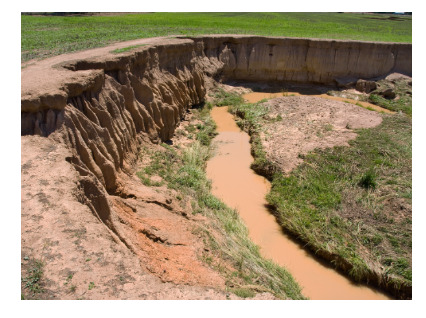Table of Contents
Introduction
Soil erosion is the natural process in which the topsoil of a field is carried away by physical sources such as wind and water.
Soil erosion refers to the process by which soil is displaced or washed away from its original location. It occurs when the natural balance of soil formation and soil loss is disrupted, leading to the removal of fertile topsoil. Soil erosion can be caused by natural factors such as wind, water, and gravity, but human activities such as deforestation, improper land management, and intensive agriculture can greatly accelerate the process. Soil erosion poses significant environmental and agricultural challenges as it leads to the loss of fertile soil, reduced water quality, decreased agricultural productivity, and land degradation. It is essential to implement soil conservation practices to prevent soil erosion and preserve the health and productivity of the land.

Causes of soil erosion
- Water Erosion: This occurs when water runoff carries away soil particles. Factors that contribute to water erosion include heavy rainfall, inadequate vegetative cover, steep slopes, and poor soil structure.
- Wind Erosion: Wind erosion happens when strong winds blow away the top layer of soil. It is more common in arid and semi-arid regions with dry and loose soils, lack of vegetation, and exposed surfaces.
- Poor Agricultural Practices: Improper land management practices such as overgrazing, excessive tilling, and monoculture agriculture can increase soil erosion. These practices leave the soil vulnerable to erosion by removing protective vegetation cover and disrupting soil structure.
- Deforestation: Clearing forests for agriculture, urbanization, or logging removes the protective canopy and exposes the soil to erosion by wind and water. The root systems of trees also help stabilize the soil, so their removal can lead to increased erosion.
- Construction and Urbanization: Construction activities, such as land clearing, excavation, and improper drainage systems, can disrupt the natural landscape and lead to accelerated soil erosion.
- Natural Factors: Natural events like earthquakes, landslides, and volcanic eruptions can cause significant soil erosion, particularly on steep slopes and in mountainous regions.
- Soil Degradation: Soil degradation, caused by factors such as nutrient depletion, compaction, and salinization, weakens the soil’s structure and reduces its ability to resist erosion.
- Climate Change: Changing climate patterns, including increased rainfall intensity and frequency, prolonged droughts, and extreme weather events, can exacerbate soil erosion by intensifying water runoff and wind erosion.
- Rainfall: Soil erosion caused by rainfall is a natural process that occurs when rainwater carries away soil particles from the land surface. It is one of the most common forms of soil erosion and can have significant environmental and agricultural impacts.
- Sheet Erosion: Sheet erosion occurs when a thin layer of soil is uniformly removed over a large area due to the flow of water as a continuous sheet. It is common on sloping lands and can lead to the loss of valuable topsoil.
- Rill Erosion: Rill erosion is characterized by the formation of small, shallow channels called rills on the soil surface. These rills are created by concentrated flow of water and can enlarge over time if not addressed. Rill erosion is more prominent on moderately sloping lands.
- Gully Erosion: Gully erosion occurs when rills become deep and wide channels known as gullies. It is usually the result of continued water flow in existing rills, or from the convergence of multiple rills. Gully erosion can cause significant soil loss and reshape the landscape.
- Splash Erosion: Splash erosion is the initial stage of soil erosion, where raindrops detach and displace soil particles upon impact. These displaced soil particles can then be transported by runoff. Splash erosion is more common on bare or poorly vegetated soil surfaces.
These types of soil erosion can have detrimental effects on agricultural productivity, water quality, and overall ecosystem health. Implementing erosion control measures, such as contour plowing, terracing, and the use of cover crops, is crucial to prevent and mitigate soil erosion caused by rainfall.
It is important to implement erosion control measures, such as terracing, contour farming, reforestation, and the use of cover crops, to mitigate soil erosion and protect the health and productivity of the land.
Effects of Soil Erosion
Soil erosion can have several negative effects on the environment, agriculture, and overall ecosystem stability. Here are some key effects of soil erosion:
- Loss of Topsoil: Soil erosion removes the fertile topsoil layer, which is rich in organic matter, nutrients, and microorganisms essential for plant growth. The loss of topsoil reduces soil fertility, making it challenging for plants to thrive and affecting agricultural productivity.
- Reduced Water Quality: Soil erosion can lead to sedimentation in rivers, streams, and other water bodies. The sediment-laden water reduces water quality, disrupts aquatic ecosystems, and affects aquatic plant and animal life. It can also clog irrigation systems and reservoirs.
- Increased Flooding and Runoff: Eroded soil particles can accumulate in drainage channels and block their capacity to carry water. This can result in increased surface runoff and localized flooding, as well as an increased risk of landslides in hilly areas.
- Nutrient Loss and Imbalance: Erosion removes not only soil particles but also essential nutrients needed for plant growth. The loss of nutrients can lead to nutrient imbalances in the soil, affecting plant health and productivity. It can also result in nutrient pollution in nearby water bodies when eroded sediments containing fertilizers and other chemicals are transported.
- Soil Compaction: Erosion can lead to soil compaction, particularly in areas where heavy machinery is used. Compacted soils have reduced water infiltration and drainage capacity, limiting root growth and affecting plant health.
- Desertification: In severe cases, soil erosion can contribute to desertification, the process by which fertile land turns into arid desert. When topsoil is lost, it becomes challenging for vegetation to establish, and the area becomes more susceptible to erosion and further degradation.
- Loss of Biodiversity: Soil erosion can disrupt habitats and ecosystems, leading to the loss of biodiversity. Many organisms, including microorganisms, insects, and plants, rely on a healthy soil environment for their survival. When soil erosion occurs, it can disrupt their habitat and negatively impact the overall ecosystem.
To mitigate the effects of soil erosion, various conservation practices can be employed, such as implementing erosion control measures, practicing sustainable land management, reforestation, contour plowing, and terracing. These practices help to prevent soil erosion, protect the soil, and maintain ecosystem stability.
Soil Erosion Prevention
Soil erosion can be prevented or minimized through various preventive measures. Here are some effective strategies for soil erosion prevention:
- Plant Vegetation: Vegetation, especially grasses and trees, plays a crucial role in preventing soil erosion. Planting and maintaining vegetation cover on bare or vulnerable soil helps bind the soil particles together, reducing the impact of rainfall and wind erosion.
- Terracing: Terracing involves constructing level platforms on steep slopes to create a series of steps. This helps slow down the flow of water and reduces soil erosion by preventing runoff from gaining excessive speed. Terraces can be combined with contour plowing to further enhance erosion control.
- Contour Plowing: Contour plowing involves plowing across the slope rather than up and down. By following the natural contour lines of the land, contour plowing helps to slow down the flow of water, reduce runoff, and prevent soil erosion.
- Conservation Tillage: Conservation tillage techniques, such as minimum tillage or no-till farming, help reduce soil disturbance. By leaving crop residues on the soil surface, conservation tillage practices protect the soil from erosion caused by wind and water.
- Mulching: Applying organic mulch, such as straw or wood chips, on the soil surface helps protect against erosion by reducing the impact of rainfall and promoting water infiltration. Mulch also helps retain soil moisture and prevents soil crusting.
- Soil Conservation Practices: Implementing soil conservation practices, such as contour bunding, strip cropping, and windbreaks, can effectively reduce soil erosion. These practices help break the flow of water and wind, reducing their erosive power.
- Proper Irrigation Management: Improper irrigation practices can lead to excessive runoff and soil erosion. Implementing efficient irrigation systems, such as drip irrigation or sprinkler systems, helps deliver water directly to the plants’ root zones, minimizing water runoff and erosion.
- Soil Cover and Stabilization: To prevent soil erosion, it is essential to maintain ground cover on vulnerable areas. This can be achieved through methods like revegetation, using erosion control blankets or mats, and installing erosion control structures such as retaining walls or gabions.
- Soil Amendments: Adding organic matter, such as compost or manure, to the soil can improve soil structure, water-holding capacity, and overall stability. This helps prevent erosion by enhancing the soil’s ability to resist the forces of erosion.
- Education and Awareness: Promoting education and awareness about soil erosion and its prevention is crucial. Providing information and training to farmers, landowners, and the general public on proper land management practices and the importance of soil conservation can help foster a culture of soil erosion prevention.
By implementing these preventive measures, we can effectively reduce soil erosion, protect our valuable topsoil, and ensure sustainable land use practices.
Frequently Asked Questions on Soil Erosion
What is soil erosion and its causes?
Soil erosion is the process of the detachment and displacement of soil particles from the land's surface by natural forces such as wind, water, or human activities. Common causes of soil erosion include water runoff, wind, improper land management practices, deforestation, overgrazing, and construction activities.
What are 5 types of soil erosion?
The five types of soil erosion are sheet erosion, rill erosion, gully erosion, tunnel erosion, and mass movement erosion. Each type varies in intensity and scale, but they all involve the loss of soil from the land.
What are the effects of erosion?
Soil erosion can have several adverse effects on the environment and human activities. These effects include loss of topsoil, reduced soil fertility, decreased agricultural productivity, sedimentation in rivers and lakes, water pollution, increased flood risk, habitat degradation, and desertification.
How we can prevent soil erosion?
Soil erosion can be prevented or minimized through various methods. These include planting vegetation, contour plowing, terracing, conservation tillage, mulching, implementing soil conservation practices, proper irrigation management, soil cover and stabilization, and educating and raising awareness about soil erosion prevention.
What is an example of erosion?
An example of erosion is the gradual wearing away of coastal cliffs by the action of waves and tidal forces. This results in the loss of land and can lead to the formation of features such as sea caves, sea stacks, and cliffs.
What are the factors affecting soil erosion?
Several factors can influence the rate and severity of soil erosion. These include climate, topography, soil type and structure, land use practices, vegetation cover, intensity and duration of rainfall, wind speed, slope steepness, and human activities such as deforestation and overgrazing.
What is the conclusion of soil erosion?
Soil erosion is a significant environmental issue with detrimental effects on ecosystems and human livelihoods. It is essential to implement effective soil conservation measures and sustainable land management practices to prevent soil erosion, protect soil resources, and ensure long-term environmental sustainability.
Does soil erosion influence soil fertility? How?
Yes, soil erosion reduces the soil's fertile top layer. This exposes the hard rocky lower layers, which are less fertile and have less humus, decreasing the soil's fertility.




